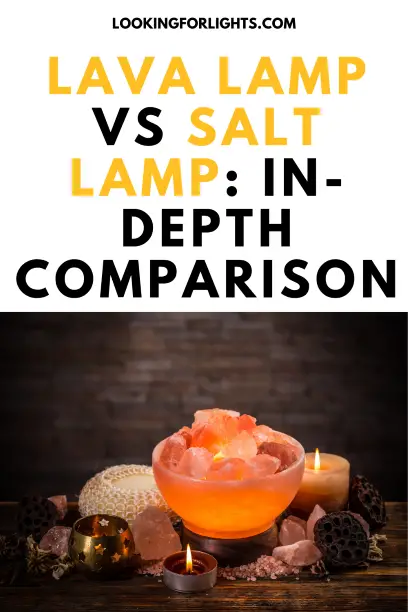
There is no dearth of lamp choices today when it comes to meeting your lighting requirements. Most lamps not only brighten up the room but also offer a number of benefits.
Lava lamps and salt lamps are two popular lamps. While the former is best known for its beauty and visual appeal, the latter is often sought after for its health benefits.
A lava lamp is not recommended to be left ON for over eight to ten hours for longevity. On the other hand, a salt lamp can be left ON the whole day. This will in fact lessen the chance of sweating.
Here are some aspects that you must know regarding both the lamps to make an informed buying decision on what works best for you.
Table of Contents
Lava Lamp vs Salt Lamp
Key Components
A lava lamp has two key components that contribute to its lighting. One of them is a colored wax while the other is a colored solution. The wax rests on the solution because of its higher density. Some lamps consist of water, carbon tetrachloride, paraffin wax and mineral oil.
On the other hand, as the name indicates, the main component of a salt lamp is salt. Himalayan salt is the most preferred salt variant. Crystals of this salt with a reddish hue are used in the lamp. These crystals are chiseled in the middle to place the bulb.
Working Principle
A lava lamp is essentially a halogen lamp or an incandescent lamp placed inside a tall glass bottle that is usually tapered. When the lamp gets heated, the density of the wax resting on the colored solution begins to become lesser than that of the solution.

As a result, the wax begins to float over the liquid. It rises to the top slowly in blobs and begins to cool down and harden. When they get started, the blobs start descending. There is a metallic wire coil under the bottle that functions as a surface tension breaker and combines all the cooled blobs.
A salt lamp works on the principle of ionization. This lamp functions by releasing negative ions into the air. These ions are said to feature various health benefits. Water molecules on the surface of the lamp release negative chloride ions from the salt crystals.
These ions combine with the air molecules to form negative air ions. According to a study, salt lamps are capable of attracting allergens, pollutants, and toxins to their surface.
Choice of bulb
Generally, the lava lamp makes use of a 25 to 40 watts bulb. At normal room temperature, the wax takes about an hour to warm up and form freely moving blobs. However, if the room is colder, it can take up to two to three hours for the wax to get heated.
Most salt lamps use 7 to 15 watts incandescent light bulbs with C7 candelabra bases. Fluorescent bulbs and tungsten filaments are better suited for salt lamps when compared to traditional LEDs. This is because the health benefits associated with these lamps are with the salt inside heating the lamp on the outside.
Where to place
There is no hard and fast rule as to where you should keep the lamp. However, it is common sense to place them in the room that you are likely to use the most.
For best results, a lava lamp must be kept in a place that is not subject to direct sunlight. This is because direct sunlight can result in fading of the colors of the lamp. The room should also not be extremely cold as this can affect the functionality of the lamp as well.
The most commonly preferred place for a salt lamp is the bedroom. This is because of the healing property associated with it. Most people prefer keeping it close to their bed as a night light. Some others prefer keeping it near their favorite chair.
The lamp should not be kept in a place where it comes directly in contact with water. Avoid keeping it over electronics or in wet areas such as outdoors or bathrooms as it tends to absorb moisture.
Maintenance/taking care
Both lamps can last a long time if they are cared for and handled properly. If your lamp comes with any specific set of instructions, make sure that you follow them carefully.
Ideally, you must keep a lava lamp in a room that is neither too hot nor too cold. Also, you must give the lamp sufficient time to warm up properly. This can be anywhere between two to six hours the first time. You should also remember to not drop, move or shake the lamp when it is warm as this can make it cloudy.
If you have a cloudy lamp, allow the wax to settle down undisturbed for about eight hours at room temperature. After this period, switch ON the lamp and wait for the wax to start becoming soft. Turn it OFF and allow the lamp to cool again. Once it is cooled, you can turn the lamp ON again and allow it to remain so for around eight to ten hours.
If the wax settles down as a single large blob at the bottom, it is likely that the metal coil generating the heat has moved out of position. Checking this and putting the coil back in place should help. You can also lookout for a wrong bulb installation or a dead light bulb.
You must clean your lava lamp only when it is cool. Dust your lava lamp every week with a clean dry cloth. Alternatively, you can use a clean cloth damped with warm water and wipe the lamp after unplugging it. Follow up with a wipe using a dry cloth so that the lamp is dry when you turn it ON. If you notice stains on the lamp, you can add some mild liquid soap to the warm water.
A salt lamp requires practically minimum or no maintenance at all. Take care not to immerse the lamp in water. You can often clean it using a damp microfiber cloth. Ensure that the cloth is not overly damp as this may cause the excess salt to get dissolved. After this is done, wipe the lamp once again with a dry cloth. Do not wash the lamp directly under running water.
Conclusion
Lava lamps and salt lamps are generally safe to use if you use them with caution and adhere to their maintenance instructions. Keep in mind that you will often need to be extra careful with them if you have children and/or pets around the house as they may knock down the lamps accidentally.
